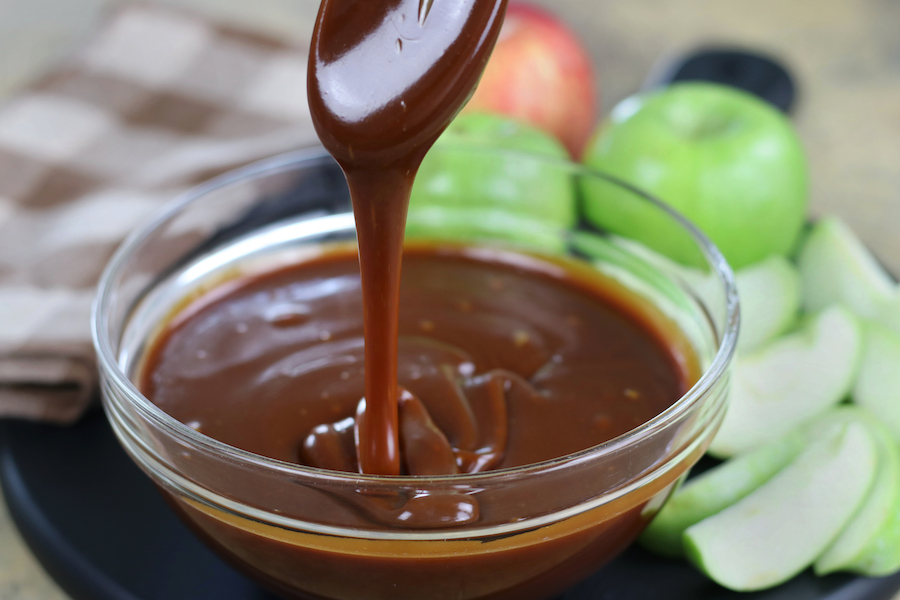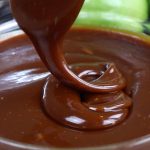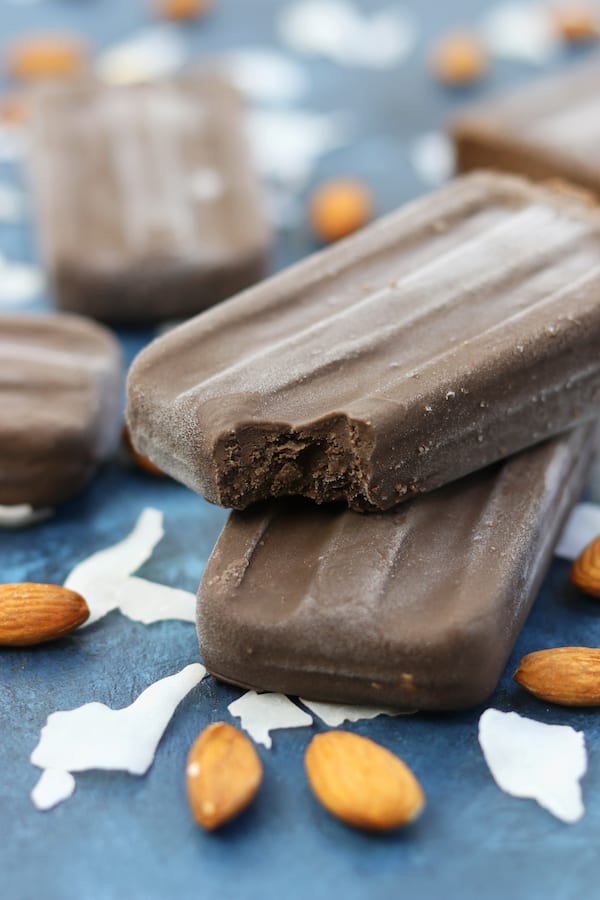Dark Caramel Sauce
Silky smooth homemade Dark Caramel Sauce comes together with simple ingredients using these tried and true steps. This recipe creates a rich, indulgent drizzle that transforms any dessert into a decadent masterpiece or can be made into a luxurious caramel candy.

This post may contain affiliate links which I earn a small portion in sales if a purchase is made. Rest assured though, it is never at any additional cost to you.

Temperature Guidelines: Light to Dark Caramel Sauce and Liquid to Chewy Caramel
The flavors and characteristics of light caramel sauce vs. dark caramel sauce are very distinct from each other. Light caramel sauce has a milder, sweeter, and more delicate flavor. On the other hand, dark caramel sauce has a richer, more intense toffee flavor.
While the approaches are very similar, the main distinction in making dark caramel sauce lies in the temperature at which the sugar is cooked to before adding the remaining ingredients. For a light colored caramel sauce cook the sugar to 320℉-340℉, 355-360℉ for a medium colored sauce and 365℉- 380℉ for a dark colored caramel sauce.
Additionally, the texture of your caramel is dependent on its final temperature. For a fluid caramel the final temperature should be 220℉. A spreadable caramel should be cooked to 230℉ as a final temperature and a firm and chewy caramel should end at 245℉.
With these temperature guidelines you are able to personalize your caramel sauce and/or caramel candy to your desired color and texture.

Benefits of Using a Candy Thermometer
Most people cringe at the idea of having to use a candy thermometer. However, there are immense amount of benefits to making this dark caramel sauce with a thermometer.
- Precision Temperature Control– A candy thermometer provides precise temperature readings, allowing you to control the caramelization process with accuracy. Caramel undergoes distinct chemical changes at different temperature stages as seen in the above chart, and a thermometer ensures you hit the desired range for your specific caramel sauce.
- Consistency in Results-Using a thermometer ensures consistency from batch to batch. Achieving the same temperature each time you make caramel sauce helps replicate the same flavor and texture, so your favorite recipes always turn out as expected.
- Prevents Overcooking and Burning-Caramel can go from a rich golden hue to burnt in a matter of seconds. A candy thermometer helps you avoid overcooking or burning the sugar by alerting you when it’s nearing the desired temperature range.
Achieving Consistency with Ingredient Weighing
When it comes to creating perfect caramel sauce, consistency is key. Achieving the same delectable results every time you make caramel sauce can be challenging, but one essential practice that ensures success is ingredient weighing.
Weighing your ingredients, especially sugar, ensures that you are using the same proportions every time you make caramel sauce. Consistency in ingredient ratios is essential for achieving consistent flavor and texture.
Important Steps Before You Start
Room Temperature or Warm Cream
Part of achieving a luxurious smooth textured caramel sauce is using warm cream. Not only will this lend to faster emulsification, it will also prevent the sugar from crystallizing.
Since heavy cream can be susceptible to bacterial growth I highly recommend to warm it on the stovetop (rather than leaving to warm at room temperature) to a temperature of 80℉ -100℉ before beginning your caramel sauce. First test your thermometer and then weigh the heavy cream into a small saucepan (see sections below). Gently heat on low heat stirring continuously until the cream reaches the desired temperature. Note: Be cautious not to overheat, as cream can scorch easily.
Testing Your Candy Thermometer
Before you embark on your caramel sauce adventure, it’s crucial to ensure the accuracy of your candy thermometer. Here’s a quick test using boiling water to verify its reliability:
- Boil Water: Begin by bringing a pot of water to a rolling boil. Make sure there’s enough water to fully immerse the thermometer.
- Insert the Thermometer: Carefully place your candy thermometer into the boiling water, ensuring the sensor tip is fully submerged but not touching the bottom or sides of the pot.
- Observe the Reading: Allow the thermometer to sit in the boiling water for a few minutes. It should register at 212 degrees Fahrenheit (100 degrees Celsius) at sea level, the boiling point of water.
- Recipe Modification: If the thermometer reads, for instance, 208 degrees Fahrenheit while water is at a rapid boil, you will need to subtract 4 degrees off of the target temperature the recipe calls for. As an example, the recipe calls for the sugar to be cooked to 365℉. Since your thermometer is reading 4 degrees lower than it should, cook the sugar to 361℉ instead.
Note: With every 500 feet above sea level, the boiling point of water is lowered by 1 degree.
Weigh the Ingredients
- Gather Your Ingredients: Collect all the components needed for your caramel sauce recipe.
- Prepare Scale and Container: Turn kitchen scale on and make sure it is measuring in grams. Place container (such as heavy bottom saucepan or bowl) on scale and zero out the scale. (Also called tare the scale.)
- Weigh Each Ingredient: Add the first ingredient to the container until you reach the specified weight.
- Repeat the Process: Remove measured ingredient and repeat until all ingredients are weighed and ready to go.

Tools Needed
Ingredients
- Granulated Sugar– This is the primary sweetening agent in caramel sauce. When heated, it undergoes caramelization, transforming into a rich, golden-brown syrup.
- Heavy Whipping Cream– Adds a creamy and luxurious texture to caramel sauce. It contributes to its velvety mouthfeel and helps create a luscious consistency. Cream also aids in emulsifying the caramelized sugar and butter.
- Glucose Syrup or Light Corn Syrup– Although not needed, either one of these syrups serves as an invert sugar in caramel sauce. In other words, it plays a crucial role in preventing sugar crystallization during the caramelization process. This results in a smoother and more stable caramel sauce with a desirable mouthfeel.
- Unsalted Butter– Enriches the flavor of caramel sauce, contributes to the sauce’s creamy consistency and helps create a well-balanced, decadent taste.
- Salt– Added to caramel sauce to balance its sweetness and enhance its overall flavor profile. The salt helps cut through the richness and accentuates the caramel’s complexity, creating a more well-rounded taste.
How To Make Dark Caramel Sauce
- Test thermometer for accuracy.
- Weigh ingredients.
- Heat cream to 80℉-100℉ and then set aside.
- Heat sugar in a heavy bottom saucepan over medium heat, stirring constantly with a wooden spatula, until it reaches 365℉. (See chart above for a light or medium caramel sauce.)
- Slowly whisk in heavy cream.
- Add glucose syrup, butter and salt.
- Continue cooking and whisking over medium heat until the caramel sauce reaches 220℉. (230℉ will yield a spreadable caramel sauce and 245℉ will yield a firm and chewy caramel sauce when cooled.)
- Take off heat making sure to continue whisking for another minute.
- Let cool slightly before using.
Storage, Shelf Life and Reheating
- Refrigeration: Store your dark caramel sauce in an airtight container in the refrigerator. Ensure that it’s completely cooled before sealing the container. Clearly label the container with the date when you made the sauce. This helps you keep track of its freshness.
- Freezing: Allow the caramel sauce to cool completely before freezing. Choose a freezer safe container and leave some space for expansion when freezing.
- Storage: Homemade dark caramel sauce can typically be safely stored in the refrigerator for up to 2 to 4 weeks or frozen for up to 6 months.
- Reheating: When you’re ready to use the frozen caramel sauce, transfer it to the refrigerator and allow it to thaw slowly. Once thawed, gently reheat it on low heat, on the stovetop, stirring until it reaches the desired consistency. Be cautious not to overheat, as caramel sauce can scorch.
Variations
- Extracts– Add a few drops of your favorite extract, such as vanilla, almond, or hazelnut, to the milk before heating.
- Spices– Infuse caramel sauce with spices like cinnamon, nutmeg, or cardamom. Add the spices to the milk before warming.
- Espresso– Brew a cup of espresso and set it aside. Prepare your caramel sauce as usual. Once the sauce is ready, add the espresso. Return the saucepan to low heat and stir until the coffee is fully incorporated.
- Cayenne Pepper– Add a pinch of cayenne pepper directly to the caramel sauce while it is in its last few minutes of simmering.
Uses for Dark Caramel Sauce
Caramel sauce is a versatile treat that elevates a wide range of desserts and dishes. Here are some delicious ways to use it:
- Dessert Drizzle– This caramel sauce is perfect for drizzling over desserts like ice cream, cheesecake, or chocolate mousse. Its rich, sweet flavor adds depth and visual appeal to your favorite sweets. (Final cooking temperature should be 220℉)
- Apple Slice Dip– Serve this caramel sauce as a delightful dip for fresh apple slices. The combination of the sauce’s sweetness with the crispness of apples creates a classic and irresistible treat. (Final cooking temperature should be 230℉)
- Brownie Enhancement– Take your brownies to the next level by swirling caramel sauce into the batter before baking. It adds gooey pockets of caramel goodness to each bite. (Final cooking temperature should be 230℉)
- Pancake and Waffle Topping– Serve this Dark Caramel Sauce as an alternative to traditional syrup for pancakes, waffles, and French toast. Its caramel flavor pairs wonderfully with breakfast classics. (Final cooking temperature should be 220℉)
- Ice Cream Sundae– Create indulgent ice cream sundaes by layering scoops of your favorite ice cream with caramel sauce, whipped cream, and toppings like chopped nuts or sprinkles. (Final cooking temperature should be 220℉)
- Coffee and Beverage Sweetener– Add a spoonful of caramel sauce to your coffee, latte, or hot chocolate for a rich, caramel-infused beverage. (Final cooking temperature should be 220℉)
- Caramel Apples– Dip apples in warm caramel sauce and roll them in chopped nuts, crushed cookies, or mini chocolate chips for a fun and tasty twist on caramel apples. The sauce will harden as it cools creating a delightful candied apple. (Final cooking temperature should be 245℉)
- Cake and Cupcake Filling– Use caramel sauce as a filling for layer cakes or cupcakes. It adds a luscious surprise in the center of each bite. (Final cooking temperature should be 230℉)
- Cocktail Ingredient-Incorporate caramel sauce into your cocktail recipes for a touch of sweetness and sophistication. It can enhance drinks like caramel martinis or create unique dessert cocktails. (Final cooking temperature should be 220℉)
- Carmel Candies– Pour the caramel sauce you prepared into a 12 x 9 inch roasting pan that has been lined with parchment paper and greased with vegetable oil. Let cool completely and then remove from pan and parchment paper. Fold the sheet of caramel in half placing one layer on top of the other and then carefully cut into bite sized pieces. Wrap candies in individual sheets of parchment paper. (Final cooking temperature should be 240℉ -245℉)
Frequently Asked Questions
Are heavy whipping cream and heavy cream the same thing?
“Heavy whipping cream” and “heavy cream” are very similar, and in many cases, they can be used interchangeably. For this Dark Caramel Sauce either one may be used.
Why does caramel sauce separate?
Caramel sauce can separate for a few reasons:
- Overheating: If caramel sauce is reheated too quickly or to too high a temperature, the fats and sugars in it can separate. This can result in a greasy texture with a layer of fat floating on top.
- Insufficient Mixing: Properly emulsifying caramel sauce requires thorough stirring, especially when combining butter and cream with caramelized sugar. Inadequate mixing can lead to separation.
- Incorrect Ratios: Using incorrect ratios of sugar, butter, or cream in the recipe can result in an unstable caramel sauce that is more likely to separate.
- Temperature Fluctuations: Rapid changes in temperature, such as moving a hot caramel sauce to a cold surface, can cause separation.
- Old or Expired Ingredients: Using expired or low-quality ingredients can contribute to separation issues.
Why is salt needed?
Salt balances the sweetness and enhances the overall flavor of the caramel. However, some people prefer caramel with only a hint of salt. If this is the case for you, simply use 1-2 ounces of salt rather than the 4 ounces that the recipe calls for.
Can I substitute vegan milk and butter for the heavy cream and butter?
I would not recommend using any substitutions for this recipe. However, here is a fabulous Vegan Caramel Sauce.
More Rich and Indulgent Recipes
Mom’s Old Fashioned Swedish Apple Cake
Old Fashioned Cream Cheese Pie

Dark Caramel Sauce
Equipment
- Candy Thermometer *see Note #1 below
- Kitchen Scale *see Note #2 below
Ingredients
- 350 grams granulated sugar
- 375 grams heavy whipping cream
- 75 grams glucose syrup *or light corn syrup, see Note #3 below
- 100 grams unsalted butter
- 4 grams salt
Instructions
- Weigh all ingredients.
- Place heavy cream into a small saucepan. Heat over low heat stirring consistently until cream reaches 80℉-100℉. Set aside. (See Note #4 below.)
- Place sugar into a heavy bottomed stainless steel saucepan and place over medium heat. Stirring constantly with a wooden spatula (or high heat spatula) cook to 365℉. (The sugar should be a deep amber color.)
- Gradually pour in the warmed cream while continuously whisking. (See Note #5 below.)
- Add in glucose syrup, butter and salt.
- Continue cooking over medium heat, whisking constantly, until the mixture reaches the desired consistency: 220°F for a sauce, 230°F for a spreadable caramel at room temperature, or 245°F for a firm and chewy caramel.
- Let cool slightly if using for a sauce. Let cool to room temperature if using as a spread or chewy caramel. (See Note #6 below for storage and reheating.)
Notes
 Note #2– Weighing your ingredients, especially sugar, ensures that you are using the same proportions every time you make caramel sauce. Consistency in ingredient ratios is essential for achieving the same results each time.
Note #3– Although optional, using either glucose syrup or light corn syrup plays a crucial role in preventing sugar crystallization during the caramelization process. In other words, by using either of these syrups you will achieve a luxuriously smooth and stable caramel sauce.
Note #4– Part of achieving a luxurious smooth textured caramel sauce is using warm cream. Not only will this lend to faster emulsification, it will also prevent the sugar from crystallizing.
Note #5– Exercise caution when incorporating the heated cream, pouring it in gradually while whisking, as it will boil rapidly.
Note #6–
Note #2– Weighing your ingredients, especially sugar, ensures that you are using the same proportions every time you make caramel sauce. Consistency in ingredient ratios is essential for achieving the same results each time.
Note #3– Although optional, using either glucose syrup or light corn syrup plays a crucial role in preventing sugar crystallization during the caramelization process. In other words, by using either of these syrups you will achieve a luxuriously smooth and stable caramel sauce.
Note #4– Part of achieving a luxurious smooth textured caramel sauce is using warm cream. Not only will this lend to faster emulsification, it will also prevent the sugar from crystallizing.
Note #5– Exercise caution when incorporating the heated cream, pouring it in gradually while whisking, as it will boil rapidly.
Note #6–
- Refrigeration: Store your dark caramel sauce in an airtight container in the refrigerator. Ensure that it’s completely cooled before sealing the container. Clearly label the container with the date when you made the sauce. This helps you keep track of its freshness.
- Freezing: Allow the caramel sauce to cool completely before freezing. Choose a freezer safe container and leave some space for expansion when freezing.
- Storage: Homemade dark caramel sauce can typically be safely stored in the refrigerator for up to 2 to 4 weeks or frozen for up to 6 months.
- Reheating: When you’re ready to use the frozen caramel sauce, transfer it to the refrigerator and allow it to thaw slowly. Once thawed, gently reheat it on low heat, on the stovetop, stirring until it reaches the desired consistency. Be cautious not to overheat, as caramel sauce can scorch.







This recipe looks incredible! You make it look so easy and just in time for fall!
Thank you so much Lee.